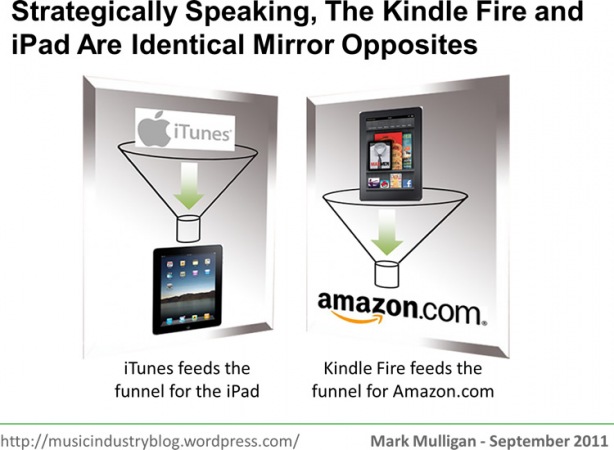In the brief pause between last week’s Kindle announcement and this week’s iPhone reveal, there has been a lot of chatter about Amazon’s perceived attack on the iPad. Too many comments assume that the digital media market is a zero-sum game with Amazon gunning for some of Apple’s market share.
Amazon’s new Kindle Fire opens the door, as several smart people have already pointed out, for it to compete ultimately with Google more than Apple.
Even if those projections don’t come to pass, the Kindle Fire represents the opening of a whole new sector of the digital media frontier. (And it is worth noting that the digital frontier is playing the same role in 21st Century America that the Western frontier played in 18th and 19th Century America.) Apple created a viable tablet computer by leveraging its app ecosystem and premium customer base. Amazon is following up with a device that gives access to its digital media reservoir at a low cost. These two strategies complement each other more than they compete. This was a point first made last week by Mark Mulligan:
Mulligan’s insight doesn’t actually go far enough. The strategies are more than mirror opposites. Each digital delivery system appeals to a different set of consumers. Apple has followed the logical outgrowth of the iPhone market by creating a luxury product with real pricing power. iPhones are status symbols equal to any tony car or fashion brand. Amazon has focused on creating a comprehensive store that will satisfy the demand of the largest number of customers at the lowest possible price. Up until now, digital media consumers who shop on price haven’t had a platform. Kindle Fire represents the best possible candidate to be that platform.
In more familiar terms, Amazon is becoming the Wal-Mart of digital media to Apple’s high-end suburban mall. Where Amazon relies on vertical control to drive down prices (let’s not forget that it continues to use its size and balance sheet to drive down ebook prices much in the way Wal-Mart pioneered,) Apple offers a luxurious, controlled environment. An app builder brings the iPad user into his universe with the same control over the atmospherics that Abercrombie has over the music, lighting, fixtures and staff.
Amazon obliterates the brands that stand between the consumer and the content; Apple steps back and relies on the app makers to build an audience and drive sales of its devices. So far, the only misstep Apple has made as a “landlord” has been to try and charge too high a rent and drive some of its anchor tenants away (e.g., the Financial Times and Amazon.)
Having viable platforms on both ends of the economic barbell is a huge plus for almost everyone in the digital media game. First of all, the faster we make this transition the better it will be for everyone—even those who will lose revenue and market-share as ad-based media declines. Squeezing the last juice from the ad-supported media has given us all manner of bizarre hook ups between content producers and distributors. At best, these are stop-gap measures like today’s ABC News-Yahoo! announcement. At worst, they’re serious sinkholes like content farms.
Second, and more important, media outlets have already begun to find good ways of making use of both the Apple and Amazon ecosystems without impinging on either. If you’re a newspaper or magazine, selling an ebook on Amazon gives non-subscribers (or just non-users) at meaningful taste of your content. We’ve already seen Vanity Fair, Slate and The New York Times do this. You’re also opening up a new revenue stream when you start down this road and those guys need new revenue like no one’s business.
This straddle between subscription-based and single-purchase content can strengthen both sides of the digital information economy and the brands that operate in between. In print, television and the movies, the power of the episodic series, whether it’s a recurring character or a multi-part story, is the one proven economic model. Creating episodic work generates marketing and revenue opportunities with each new release. It also strengthens the producer/distributor who can establish a new hit by delivering an audience then benefit from the secondary rights.
The dam that’s been holding back a flood of digital content from tablet devices is the producer’s fear that they will have terms dictated to them by Apple or Netflix. They’ve also got to protect their existing relationships with their primary carriers and clients, the cable companies. Amazon’s entry into this world strengthens the digital distribution side. If Kindle Fire fails, the process of migrating content from cable to digital will take much longer as everyone digs in their heels. But Amazon’s deep pockets will present an immediate advantage to some seller who will eventually prove the case. At that point, even Netflix will regain some of its lost luster.
Netflix has lost its momentum as a stock, plummeting 60%, and Hulu no longer looks like it will find a buyer. Amazon’s new Kindle puts a lot of pressure on both companies. The good news is that having Amazon as an alternative will give producers more than one bidder for their content. In the short term, that massively reduces expectations for Netflix. In the long-term, if Netflix can get beyond the strategy of being a comprehensive source for video content (or, at least, develop a business model that works for the producers) it should still do quite well.
Kindle Fire has to gain traction. When it does there will be renewed interest in getting content onto the iPad. It will be an imperative, in fact, to counter-weight Amazon’s wealth with Apple’s very large customer base.
The result will put more content behind an effective and enforceable paywall. And that’s good for everyone (including consumers.)
Source:
Amazon’s and Apple’s Mirror Opposite Content Strategies
by Mark Mulligan
Music Industry Blog; September 28, 2011
http://musicindustryblog.wordpress.com/2011/09/28/amazons-and-apples-mirror-opposite-content-strategies/



What's been said:
Discussions found on the web: